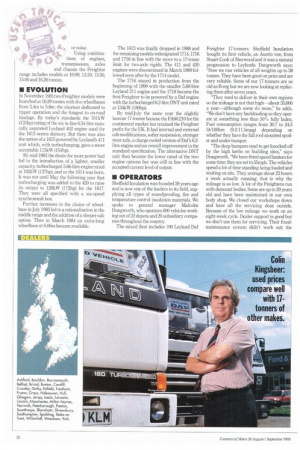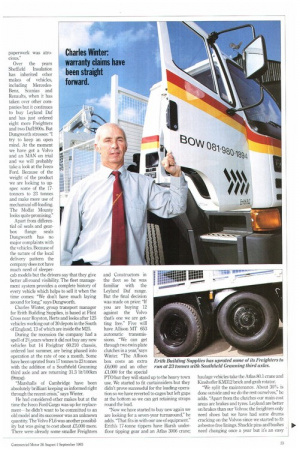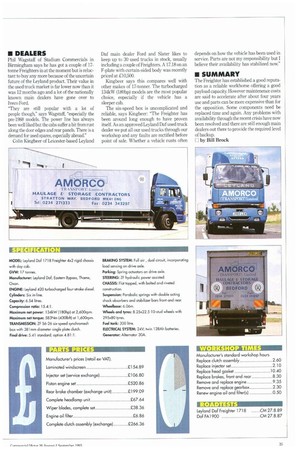• EVOLUTION
Page 34

Page 35

Page 36

Page 37

If you've noticed an error in this article please click here to report it so we can fix it.
In November 1981two Freighter models were launched at 16.29 tonnes with five wheelbases from 3.4m to 5.8m: the shortest dedicated to tipper operation and the longest to on-road haulage. By today's standards the 101kW (135hp) rating of the six in-line 6.54-litre naturally aspirated Leyland 402 engine used for the 1613 seems derisory. But there was also the option of a 1615 powered by Leyland's 411 unit which, with turbocharging, gave a more acceptable 115kW (151hp).
By mid-1983 the desire for more power had led to the introduction of a lighter, smaller capacity, turbocharged 5.66-litre engine rated at 102kW (137hp), and so the 1614 was born. It was not until May the following year that turbocharging was added to the 420 to raise its output to 128kW (172hp) for the 1617. They were all specified with a six-speed synchromesh box.
Further increases in the choice of wheelbase in July 1983 led to a rationalisation in the middle range and the addition of a sleeper-cab option. Then in March 1984 an extra-long wheelbase at 6.06m became available.
The 1613 was finally dropped in 1988 and the remaining models redesignated 1714, 1716 and 1718 in line with the move to a 17-tonne limit for two-axle rigids. The 411 and 420 engines were discontinued in March 1989 followed soon after by the 1714 model.
The 1716 stayed in production from the beginning of 1990 with the smaller 5.88-litre Leyland 311 engine and the 1718 became the first Freighter to be powered by a Daf engine with the turbocharged 6.2-litre DNT unit rated at 134kW (180hp).
By mid-July the same year the slightly heavier 17-tonner became the FA60.210 for the continental market but retained the Freighter prefix for the UK. It had internal and external cab modifications, softer suspension, stronger steer axle, a charge cooled version of Oaf's 6.2litre engine and an overall improvement in the standard specification. The alternative DNT unit then became the lower rated of the two engine options but was still in line with the accepted current level of output.
Sheffield Insulation was founded 28 years ago and is now one of the leaders in its field, supplying all types of soundproofing, fire and temperature control insulation materials. We spoke to general manager Malcolm Dungworth, who operates 600 vehicles working out of 22 depots and 20 subsidiary companies throughout the country.
The mixed fleet includes 100 Leyland Oaf Freighter 17-tonners. Sheffield Insulation bought its first vehicle, an Austin van, from Stuart Cook of Sherwood and it was a natural progression to Leylands. Dungworth says: "Now we run vehicles of all weights up to 38 tonnes. They have been good on price and are very reliable. Some of our 17-tonners are as old as B-reg but we are now looking at replacing them after seven years.
"They tend to deliver in their own regions so the mileage is not that high—about 35,000 a year—although some do more," he adds. "We don't have any backloading so they operate at something less than 50% fully laden. Fuel consumption ranges from 30.7 to 24.5 lit./1C0km (9.2-11.5mpg) depending on whether they have the full roof-mounted spoiler and under-bumper.
"The deep bumpers tend to get knocked off by the high kerbs on building sites," says Dungworth. "We have fitted speed limiters for some time; they are set to 55mph. The vehicles spend a lot of time standing being loaded and waiting on site. They average about 23 hours a week actually running; that is why the mileage is so low. A lot of the Freighters run with demount bodies. Some are up to 20 years old and have been maintained in our own body shop. We closed our workshops down and have all the servicing done outside. Because of the low mileage we work on an eight-week cycle. Dealer support is good but we don't use them for servicing. Their fixedmaintenance system didn't work out; the paperwork was atrocious."
Over the years Sheffield Insulation has inherited other makes of vehicles, including MercedesBenz, Scanias and Renaults, when it has taken over other companies but it continues to buy Leyland Daf and has just ordered eight more Freighters and two Daf1900s. But Dungworth stresses: "I try to keep an open mind. At the moment we have got a Volvo and an MAN on trial and we will probably take a look at the Iveco Ford. Because of the weight of the product we are looking to upspec some of the 17tonners to 23 tonnes and make more use of mechanical off-loading. The Moffat Mounty looks quite promising."
Apart from differential oil seals and gearbox flange seals Dungworth has no major complaints with the vehicles. Because of the nature of the local delivery pattern the company does not have much need of sleeper cab models but the drivers say that they give better all-round visibility The fleet management system provides a complete history of every vehicle which helps to sell it when the time comes: "We don't have much laying around for long," says Dungworth.
Charles Winter, group transport manager for Erith Building Supplies, is based at Flint Cross near Royston, Herts and looks after 125 vehicles working out of 30 depots in the South of England, 13 of which are inside the M25.
During the recession the company had a spell of 2I/2years where it did not buy any new vehicles but 14 Freighter 60.210 chassis, ordered last summer, are being phased into operation at the rate of one a month. Some have been uprated from 17 tonnes to 23 tonnes with the addition of a Southfield Granning third axle and are returning 31.3 lit/1001cm (9mpg).
"Marshalls of Cambridge have been absolutely brilliant keeping us informed right through the recent crisis," says Winter.
He had considered other makes but at the time the Iveco Ford Cargo was up for replacement—he didn't want to be committed to an old model and its successor was an unknown quantity. The Volvo FL6 was another possibility but was going to cost about £5,000 more. There were already some smaller Freighters and Constructors in the fleet so he was familiar with the Leyland Daf range. But the final decision was made on price: "If you are buying 12 against the Volvo that's one we are getting free." Five will have Allison MT 653 automatic transmissions. "We can get through two twin plate clutches in a year,"says Winter. "The Allison box costs an extra £6,000 and an other £1,000 for the special PTO but they will stand up to the heavy town use. We started to fit curtainsiders but they didn't prove successful for the loading operation so we have reverted to cages but left gaps at the bottom so we can get retaining straps round the load.
"Now we have started to buy new again we are looking for a seven-year turnaround," he adds. "That fits in with our use of equipment." Erith's 17-tonne tippers have Harsh underfloor tipping gear and an Atlas 3006 crane;
O 0000110110010110 00111111110
▪ roviesierviso0 No011111
0000 •000•001 MM ipww ••••••''""
haulage vehicles take the Atlas 80.1 crane and Kinshoffer KM312 brick and grab rotator.
"We split the maintenance. About 30% is done outside and we do the rest ourselves," he adds. "Apart from the clutches our main cost areas are brakes and tyres. Leyland are better on brakes than our Volvos: the freighters only need shoes but we have had some drums cracking on the Volvos since we started to fit asbestos-free linings. Shackle pins and bushes need changing once a year but it's an easy
A4 enough job. The panels behind the door on some of the NO older models have rusted. After about four to five years the header tanks start to leak and have to be replaced.
"Warranty claims have been straight forward," Winter reports. "A leaking rear seal on the gearbox was put right overnight. There is another one with a problem on second gear; it keeps jumping out of mesh. We're waiting for that to be done. All new models are fitted with autolube but the basic spec vehicle suits our operation. The cab trim stands up OK—initially the drivers were slow to accept the Leyland cab but there are no complaints and they like the power of the 210 engine. Comparing costs over a five-year period there is very little difference between one make and another."
Terry Stratton started Amore°, his haulage and storage business, 26 years ago and always ran Ford and Bedfords, some on test for GM. With the departure of Bedford he stayed with British-built vehicles and bought Leyland. Now, with his son John, he runs a mixed fleet of 30 vehicles including Volvos, !yew Fords and Leyland Dafs. Five are Freighter 17.18s and one is an FA60.180. Fuel consumption ranges from 35.3 to 25.71ft/100bn (8-11 mpg) depending on the driver and whether the trucks are fitted with a roof-mounted wind deflector and underbumper air dam. The Volvo FL18s do slightly better at around 23.51it/1001un (12mpg) while the Iveco Ford Cargos average 28.325.71it/100km (10-11mpg). The vehicles operate nationwide but payloads are often less than six tonnes and only occasionally reach 10 tonnes. The operation calls for cube rather than weight and two are fitted with 8.53m GRP bodies on the longest 6.01m wheelbase: the rest are 7.31m long.
"We have always had quite a good deal from Leyland Daf," says Stratton, "but all of the manufacturers are competitive on price today. Volvo and Seddon Atkinson are slightly cheaper at the moment, before discounts the Volvo FL18 is about £1,500 less than the Freighter spec for spec, except that the Volvo includes a night heater. By the time you add on a locally built body and a Ray Smith taillift you're back up to the original list price. The Volvo's specification is better but the Leyland gives us over half a tonne more payload.We like to change them after five years," he adds, "but our oldest are now 1985 registrations. In the future we will be looking for a six-year life. We are about to buy eight new vehicles and that will bring us back into line but we haven't seen anyone from Leyland Daf for some time.
"The Freighters work well," Stratton adds, "but having to keep them a bit longer than we would wish has cost us a lot of money on maintenance. The cost really begins to rise after three to four years. Rear brake drums run oval and have to be skimmed to give an acceptable braking performance. Plastic bushes in the spring shackles need replacing every service—it took us two years to get the part number out of the dealer for the brass bush. Since we have fitted them we haven't needed another since. Cab rust is a problem. One, on an E plate with rust spots all over, has been resprayed three times.
"Our biggest complaint is the availability and price of Leyland Daf spare parts," he says. "I'll give you an example: for a Freighter a new dipstick and tube cost £65 and a windscreen motor cost £265. The same parts for a Cargo cost £15 and £65. Lack of a part on the shelf at the dealer means it has to be ordered VOR and we lose our discount. We can get parts cheaper and quicker from a factor than Leyland Daf. The cost of genuine parts is a major concern to us and will certainly figure in our decision in choosing replacements". Phil Wagstaff of Stadium Commercials in Birmingham says he has got a couple of 17tonne Freighters in at the moment but is reluctant to buy any more because of the uncertain future of the Leyland product. Their value in the used truck market is far lower now than it was 12 months ago and a lot of the nationally known main dealers have gone over to Iveco Ford.
"They are still popular with a lot of people though," says Wagstaff, "especially the pre-1988 models. The power line has always been well liked but the cabs suffer a bit from rust along the door edges and rear panels. There is a demand for used spares, especially abroad."
Cohn Kingbeer of Leicester-based Leyland Daf main dealer Ford and Slater likes to keep up to 30 used trucks in stock, usually including a couple of Freighters A 17.18 on an F-plate with curtain-sided body was recently priced at £10,930.
Kingbeer says this compares well with other makes of 17-tonner. The turbocharged 134kW (180hp) models are the most popular choice, especially if the vehicle has a sleeper cab.
The six-speed box is uncomplicated and reliable, says Kingbeer: "The Freighter has been around long enough to have proven itself. As an approved Leyland Daf used truck dealer we put all our used trucks through our workshop and any faults are rectified before point of sale. Whether a vehicle rusts often
depends on how the vehicle has been used in service. Parts are not my responsibility but I believe their availability has stabilized now."
The Freighter has established a good reputation as a reliable workhorse offering a good payload capacity. However maintenence costs are said to accelerate after about four years use and parts can be more expensive than for the opposition. Some components need be replaced time and again. Any problems with availability through the recent crisis have now been resolved and there are still enough main dealers out there to provide the required level of backup.
0 by Bill Brock












































































